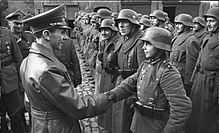Upper Silesian offensive
| Upper Silesian offensive | |||||||
|---|---|---|---|---|---|---|---|
| Part of the Silesian offensives on the Eastern Front of World War II | |||||||
 Russian map of the Silesian offensives | |||||||
| |||||||
| Belligerents | |||||||
|
|
| ||||||
| Commanders and leaders | |||||||
|
|
| ||||||
| Strength | |||||||
| unknown | 408,400[1] | ||||||
| Casualties and losses | |||||||
| unknown | 66,801 (including 15,876 irrecoverable)[1] | ||||||
The Upper Silesian offensive (
Prelude
This section needs additional citations for verification. (March 2017) |
After the end of the Soviet summer offensive of 1944 (Operation Bagration), the frontline of the Eastern Front had stabilised roughly in the middle of Poland, running from Riga on the Baltic coast over Warsaw via the Vistula to the Carpathian Mountains. Most of the pre-war German territory was still under control of the Third Reich at the end of 1944. On 12 january 1945, Soviet troops launched the simultaneous Vistula–Oder and Western Carpathian offensives.
The front lines in Silesia had been established at the end of the
Operation Gemse: the German counter-attacks at Lauban and Striegau

The commander of
The 3rd Guards Tank Army was initially taken by surprise, though by 3 March German forces found themselves threatened by Soviet counterattacks from
Despite the limited nature of the victory, the recapture of
Schörner began to organise a more ambitious offensive to the north to relieve the besieged city of
Deployments
Red Army
- Southern wing of 1st Ukrainian Front (Marshal Ivan Konev)
- 3rd Guards Tank Army (Colonel-General Pavel Rybalko)
- 4th Tank Army (General Dmitry Lelyushenko)
- 21st Army (General Dmitry Gusev)
- 60th Army (General Pavel Kurochkin)
- 59th Army (Major-General Ivan Korovnikov)
- Northern wing of Ivan Yefimovich Petrov)
- 38th Army (General Kirill Moskalenko)
Wehrmacht
Divisional assignments to Corps as of 31 Dec. 1944.[5] Units tended to move between Corps depending on situation.
- Army Group A (General Josef Harpe until 20 Jan 1945) until 25 Jan. 1945 then renamed Army Group Centre (later Army Group Schörner) (Field-Marshal Ferdinand Schörner)
- Heinrich von Lüttwitz)
- LVI Panzer Corps / Korpsgruppe Schlesien (General Rudolf Koch-Erpach)
- VIII Army Corps (General Walter Hartmann)
- incl. 6 VGD
- incl.
- 4th Panzer Army (General Fritz-Hubert Gräser)
- XXXXVIII Panzer Corps (General Maximilian von Edelsheim)
- incl. 304 ID
- incl.
- Seventeenth Army (General Friedrich Schulz)
- LIX Corps (General Edgar Röhricht later Georg Ritter von Hengl)
- incl. 544 VGD
- incl.
- XI SS Corps (SS-Obergruppenführer Matthias Kleinheisterkamp)
- incl. 78th Sturm Division, 320 VGD, 545 VGD
- LIX Corps (General Edgar Röhricht later Georg Ritter von Hengl)
- 1st Panzer Army (Colonel-General Gotthard Heinrici to 19 March, then General Walther Nehring)
- XI Corps (General Horst von Mellenthin to 19 March, then General Rudolf von Bünau)
- incl. 100 JD
- incl.
- XXXXIX Mountain Corps (General Karl von Le Suire)
- incl. 101 JD, 1 SkiJD
- incl.
- XI Corps (General Horst von Mellenthin to 19 March, then General Rudolf von Bünau)
- 1st Hungarian Army (Colonel General Miklocz)[6]
- XVII Corps (General Wilhelm Fahrmbacher)
Also present:
- Air support from Luftflotte 4.
The offensive
Konev launched his main attack on 15 March. The 4th Tank Army broke through the German lines west of Oppeln and drove directly southward, heading for Neustadt. A subsidiary attack by the 4th Guards Tank Corps fanned out to take Neisse. South-east of Oppeln, the 59th and 60th Armies also broke through, the former swinging westwards to link up with the 4th Tank Army. The First Panzer Army's XI Corps, holding the lines near Oppeln, was now threatened with encirclement.
In the south, the 38th Army attacked German troops of the
The encirclement at Oppeln
The
Konev launched further attacks on 24 March, and by 31 March, when Ratibor and Katscher were taken, was able to declare the offensive phase of operations over.[11]
Aftermath
The Upper Silesian Offensive succeeded in stabilising Konev's left flank in preparation for the advance on Berlin, and removed the threat of any German counter-attacks from Army Group Centre. The lines in Silesia remained largely unchanged until the end of the war, when Schoerner's force surrendered.
Notes
References
- ISBN 0-670-88695-5
- Duffy, C. Red Storm on the Reich: The Soviet March on Germany, 1945, Routledge, 1991, ISBN 0-415-22829-8.
- David M. Glantz, The Soviet-German War 1941–45: Myths and Realities: A Survey Essay.
- Georg Gunter, Last Laurels: The German Defence of Upper Silesia, Helion & Company, 2002, ISBN 1-874622-65-5.
Further reading
- Georg Gunter, Duncan Rogers, Last Laurels: The German Defence of Upper Silesia, January–May 1945, Helion & Co., 2002, ISBN 1-874622-65-5.
